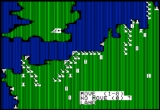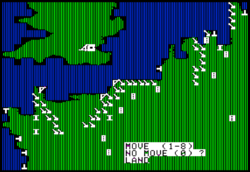
50 Mission Crush
Encyclopedia

Strategic Simulations, Inc.
Strategic Simulations, Inc. was a video game developer and publisher with over 100 titles to its credit since its founding in 1979. It was especially noted for its numerous wargames, its official computer game adaptations of Dungeons & Dragons, and for the groundbreaking Panzer General...
(SSI) that simulates the career of the crew of a B-17 Flying Fortress bomber during World War II
World War II
World War II, or the Second World War , was a global conflict lasting from 1939 to 1945, involving most of the world's nations—including all of the great powers—eventually forming two opposing military alliances: the Allies and the Axis...
. The bomber is based out of the RAF Thurleigh
RAF Thurleigh
RAF Thurleigh was a Royal Air Force station located five miles north of Bedford, England. Thurleigh was transferred to the U.S. Eighth Air Force on 9 December 1942, designated Station 111, and used for heavy bomber operations against Nazi Germany.-Origins:...
base just north of London
London
London is the capital city of :England and the :United Kingdom, the largest metropolitan area in the United Kingdom, and the largest urban zone in the European Union by most measures. Located on the River Thames, London has been a major settlement for two millennia, its history going back to its...
, and is part of the 8th Air Force. While most of SSI's games emphasized long-term strategic planning, 50 Mission Crush was marketed explicitly for its quick, comparatively fast pace: each mission takes no more than about 10 minutes. SSI described it as a "role-playing game". The game is sometimes referred to as "Fifty Mission Crush."
Gameplay
As compared to many of SSI's other games, 50 Mission Crush is a fairly "light" play, and does not require grand strategic planning. Each mission is self-contained, and the player does not have to worry about resupply or repairs in between missions. Every position on the plane (for example, tail gunnerTail gunner
A tail gunner or rear gunner is a crewman on a military aircraft who functions as a gunner defending against enemy fighter attacks from the rear, or "tail", of the plane. The tail gunner operates a flexible machine gun emplacement on either the top or tail end of the aircraft with a generally...
, ball gunner, radio operator, and so on) is manned by a character named by the player who gains experience with each mission survived. The more missions a character survives, the more competent he becomes.
Each mission requires that the player to bomb a specific target from a specific altitude. There is no strict time limit, but the amount of fuel the plane can carry is limited. The player decides upon take off how much fuel to carry and whether to carry an extra-heavy load of bombs. The player then moves his plane to the target using the number pad keys, and on each turn may ascend or descend in 5,000 foot increments. When the bomber is over the target, the player is meant to wait until there is no cloud cover before dropping the bombs. When the player is over an enemy target and there is no cloud cover, the enemy will typically fire flak, which can damage the plane, injure or kill crewmen, or set the plane on fire. The lower the bomber's altitude, the more intense the flak will be. The bomber may also be strafed by enemy fighter planes, such as the Focke-Wulf FW 190
Focke-Wulf Fw 190
The Focke-Wulf Fw 190 Würger was a German Second World War single-seat, single-engine fighter aircraft designed by Kurt Tank in the late 1930s. Powered by a radial engine, the 190 had ample power and was able to lift larger loads than its well-known counterpart, the Messerschmitt Bf 109...
, Messerschmitt Bf 109
Messerschmitt Bf 109
The Messerschmitt Bf 109, often called Me 109, was a German World War II fighter aircraft designed by Willy Messerschmitt and Robert Lusser during the early to mid 1930s...
, or Messerschmitt Bf 110
Messerschmitt Bf 110
The Messerschmitt Bf 110, often called Me 110, was a twin-engine heavy fighter in the service of the Luftwaffe during World War II. Hermann Göring was a proponent of the Bf 110, and nicknamed it his Eisenseiten...
.
The Term
The name "50 Mission Crush" is an allusion to a type of hat. The game manual states:A "fifty mission crush" is an Army Air Corps, or Air Force, service cap
that has the stiffening ring removed, and is worn crushed and battered. This
cap is obviously out of uniform, however steeped in tradition. This tradition
was started by the 8th Air force flying personnel as a mark that separates
the fledgling from the battle hardened survivor of 25+ combat missions. This
mangled cap was frowned upon, but tolerated for those who earned the right to
wear it.
Normally, this cap had stiffeners – a support piece behind the cap device and a wire around the inside top perimeter to maintain the cap's round shape. These kept the cap in its proper, regulation military shape and angle. However, since pilots wore headsets over their caps during flights, they would remove the wire stiffener to make headset wear more comfortable, causing the sides of the caps to become crushed. Eventually, the caps retained their floppy "crushed" look, giving the pilot who wore it the look of a seasoned veteran. The crush cap identified its wearer as an experienced pro, and was as much a part of his identity as his leather flight jacket. Army regulations authorized wear of the service cap in this manner in the Army Air Forces, although ground Army officers hated that manner of wearing the cap. Since most AAF general officers likewise wore the crushed caps, the ground Army could do nothing about it. The wear of the "50 Mission" cap is prohibited in the current USAF, since headsets are no longer worn over headgear.

